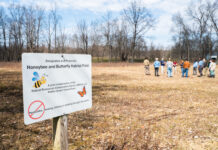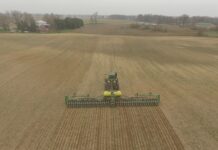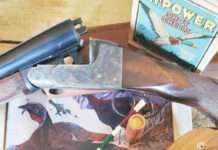
With the barnhouse having now reached a modicum of completion and some fencing for the livestock having been put into place, it was time to use the last couple of weeks before the crops needed to be harvested for felling additional trees. This would enable more crops to be planted the following year as well as provide additional fuel for the firewood-guzzling fireplace which would need to be kept burning throughout the winter months.
Cutting down more of the gigantic trees would allow more sunshine to bathe the embryonic fields, while at the same time remove habitat near the residence utilized by predators like wolves, bears and coyotes, and nuisance pests like deer, raccoons, rabbits, groundhogs and other smaller animals which loved to feast on the settlers’ meager gardens.
Because more settlers brought additional tools with them to the developing frontier community, the felling axe was replaced by the more efficient six-foot whip saw and two-man crosscut saw and the timber saw, about four feet in length. All three of these tools greatly reduced the man-killing efforts of having to chop through giant trees to fell them.
Log rolling
To accomplish this removal of trees, the settlers held what was commonly known as a “log rolling.” One of the very best descriptions of this kind of event in the early Ohio Country comes down through history in the memoirs of Major General David Sloane Stanley of Wayne County, written in 1917 and published by the Harvard University Press.
The log rolling occurred only after large trees had been felled and their huge trunks burned into manageable sections by heaping piles of branches over them, which were kept burning until the great trunks were burned into lengths.
Stanley said that the log rolling, “a term which very naturally has passed into a political by-word, generally drew half a dozen neighbors together as one or two men could not handle the big logs alone.”

“After the great trunks were burned into lengths came the process of squaring,” Stanley wrote. “A strong team of horses or oxen were used to swing around the sections of the great logs so that they laid parallel to each other. After this came the heaviest work of all – the ‘rolling.’ This consisted in rolling three or four of the largest logs together, then placing on top of these a second row, then topping out with a treble layer of the smaller logs.”
Stanley recalled that “many devices were used to ease the man-work. A strong [horse or oxen] team was always along with the log rollers; the rolling hitch with the log chains, strong skids, the cant hook and other devices were used to make the work easier.”

Those other devices included ring dogs which were widely used across The Ohio Country. These were large wrought iron hooks, a foot or more in length, each of which incorporated a heavy iron ring at the end. The sharp end of the hook was locked into the bark of the trunk being rolled. Then a long, sturdy sapling was inserted through the ring to act as a lever to help roll the log over. Several of these were often used at the same time.
“I have no doubt,” Stanley mused, “that many of our labor-saving machines had their origin in the devices for handling heavy timbers and accomplishing hard work connected with the early experiences of our pioneer settlers of America.”
After the huge log pyramid was created, it was time for the firing to begin with, Stanley wrote, “all the smaller timber and limbs being piled on to secure a good heat.”
Stanley said that the actual firing was an event that always impressed him and was seared into his memory.
“To see 10 or 15 acres (worth of timber) the day, or particularly the night, of firing was to see a grand sight, surpassing any fire scene excepting a burning city. The adjoining woods are lighted up, fences stand out in bright relief, and the sky is red with reflected firelight,” he wrote.
But Stanley regretted the destruction of some of the best timber in the world.
“The saddest part of it,” Stanley wrote, “is that hundreds of cords of the best firewood and thousands of (board) feet of the most beautiful timber, now so much sought for, were all consumed and for no purpose but simply to get rid of it.” He added, “I myself have seen a log heap of beautiful black walnut burned up, which if preserved would sell today (1916) for five hundred dollars. Walnut timber had no value then and walnut timber grew on black land — the richest of land — and it had to be removed to make way for the cornfield.”
The final stage of the log rolling was to gather up the resulting ashes. These were then hauled home to be used in the family’s ashery, which Stanley referred to as a “potash factory.” The ashes were dumped into the wooden ashery bin along with ashes from the fireplace.
There, rainwater and dishwater would filter down through the ashes and be collected in a large pan below as lye water. Lye water was used both in making homemade lye soap, as well as preparing textiles for dying. As usual, nothing useful ever went to waste on the frontier.












